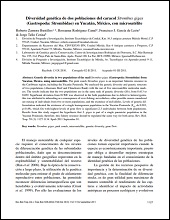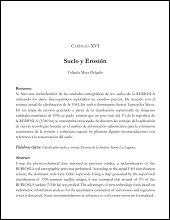Diversidad genética de dos poblaciones del caracol Strombus gigas (Gastropoda: Strombidae) en Yucatán, México, con microsatélite
Genetic diversity in two populations of the snail Strombus gigas (Gastropoda: Strombidae) from Yucatan, Mexico, using microsatellite
Autor
ROBERTO ZAMORA BUSTILLOS
ROSSANNA DEL PILAR RODRIGUEZ CANUL
FRANCISCO JAVIER GARCIA DE LEON
JORGE ARTURO TELLO CETINA
Metadatos
Mostrar el registro completo del ítemResumen
"The pink conch Strombus gigas is an important fisheries resource in the Caribbean region, including the Yucatán Peninsula. We analyzed the genetic diversity and genetic structure of two populations (Alacranes Reef and Chinchorro Bank) with the use of five microsatellite molecular markers. The results indicate that the two populations are in the same rank of genetic diversity (He), from 0.613 to 0.692. Significant deviation from H-WE was observed in the both populations due to deficit to heterozygotes, this was attributed to inbreeding as a consequence of over-fishing; nevertheless, other possible causes considered are mixing of individuals from two or more populations, and the existence of null alleles. Levels of genetic differentiation indicated the existence of a single homogenous population in the Yucatan Peninsula (FST de 0.003, p=0.49), which fits with highest levels of gene flow is significant (2.3 individuals) between both populations. Results from this study support the hypothesis that S. gigas is part of a single panmictic population in the Yucatan Peninsula; therefore, this fishery resource should be regulated the same way for both areas." "El caracol rosado S. gigas, es una especie de gran importancia pesquera en la región del Caribe que incluye la Península de Yucatán, en la cual, se analizó la diversidad y estructura genética de dos poblaciones (Arrecife Alacranes y Banco Chinchorro) mediante el uso de cinco marcadores moleculares del tipo microsatélites. Los resultados indican que las dos poblaciones analizadas se encuentran en el mismo rango de diversidad genética (He) de 0.613 a 0.692. En ambas poblaciones también se observó una desviación significativa al equilibrio H-WE, la cual fue atribuida a factores como la endogamia a consecuencia de una sobre-explotación pesquera. Sin embargo otra explicación posible es que se deba a una mezcla de individuos de dos o más poblaciones, y la existencia de alelos nulos. Los niveles de estructura genética indican la existencia de una sola población homogénea en la península de Yucatán (FST de 0.003, p=0.49) y el flujo genético fue significativo (2.3 individuos) entre las dos poblaciones. Los resultados de este estudio aceptan la hipótesis de que las poblaciones S. gigas forman parte de una sola población panmíctica en la Península de Yucatán, por lo tanto, el recurso pesquero debe regularse de igual manera en ambas regiones."
Colecciones
Ítems relacionados
Mostrando ítems relacionados por Título, autor o materia.
-
PROMOCIÓN DEL PERIFITON PARA EL CULTIVO DE CAMARÓN BLANCO: HACIA UNA ACUICULTURA ECOLÓGICA
DOMENICO VOLTOLINA LOBINA; JUAN MANUEL AUDELO NARANJO; MARIA DEL ROSARIO PACHECO MARGES -
Suelo y Erosión
YOLANDA LOURDES MAYA DELGADO


